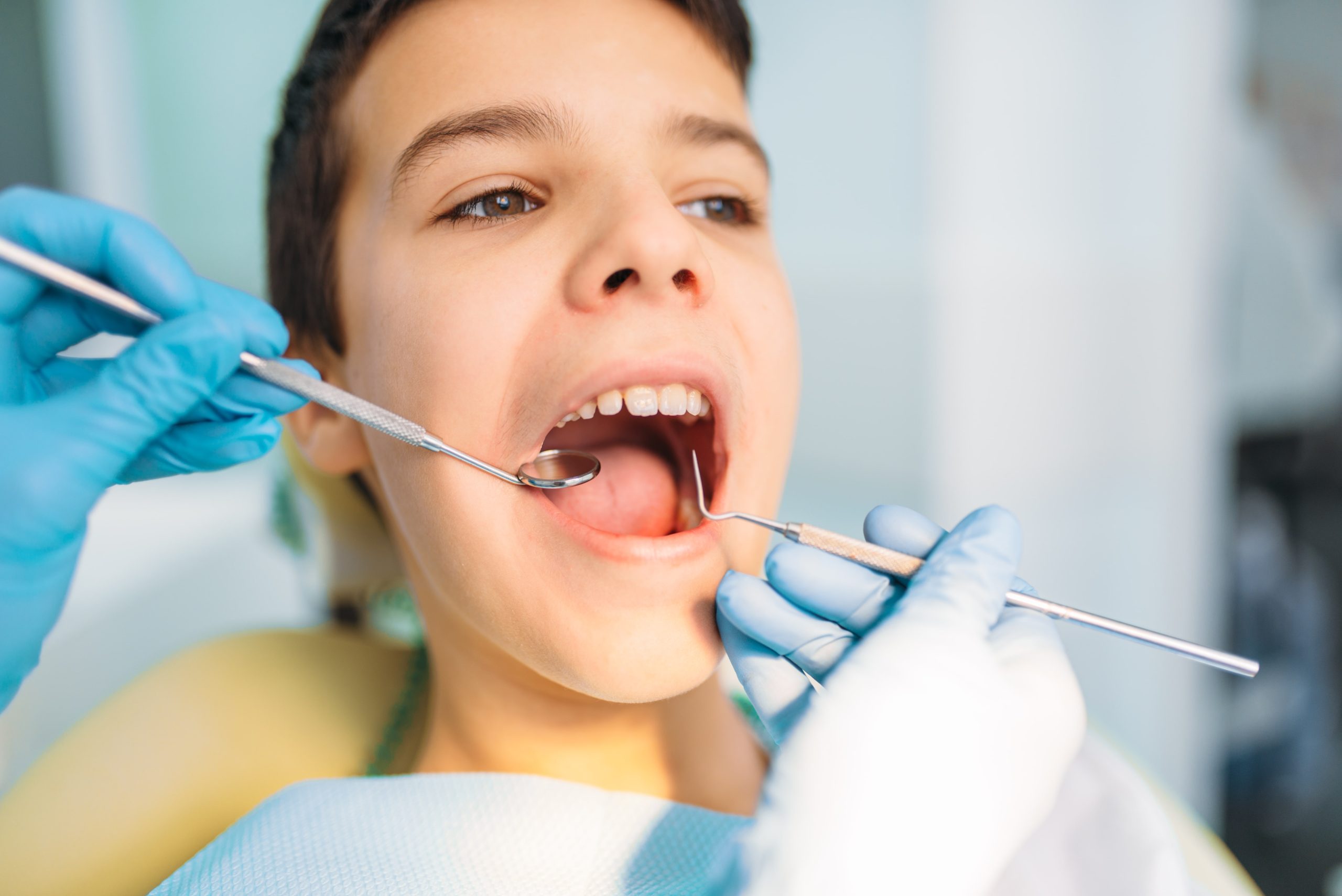Why Are The Primary Teeth Important?
Primary teeth are not just baby teeth. Neglected primary teeth increase cavity risk which often leads to problems with developing permanent teeth. Primary teeth are important to:
Allow for proper chewing and eating
Hold space for permanent teeth as they move into the correct position
Permit normal development of the jaw bones and muscles
Aid in the development of speech
Add to an attractive appearance
While front teeth last until 6-8 years of age, back teeth (canines and molars) aren’t replaced until age 10-12. In other words, kids need their primary teeth for a long time.
First Visit
You can make the first visit to the dentist enjoyable and positive.
It is best if you refrain from using words around your child that might cause unnecessary fear, such as needle, shot, pull, drill, or hurt. We make a practice of using words that convey the same message but are pleasant and non-frightening to the child.
We invite you to stay with your child during the initial examination and strive to make each and every visit to our office a fun one!
Your child’s dental checkup includes:
A visual exam of the mouth, face, jaw, and neck
Digital diagnostics
Professional cleaning and polishing of teeth
Services provided to keep your baby’s tooth safe include:
Topical Fluoride
Topical fluoride is a preventative agent applied to tooth enamel. Fluoride inhibits loss of minerals from tooth enamel and encourages remineralization, which can strengthen areas that are weakened and beginning to develop cavities. Fluoride also affects bacteria that cause cavities and discourages acid attacks that break down the tooth.
The procedure requires placing gels or foams in trays that are held against the teeth for up to 4 minutes. Fluoride varnish is brushed or painted on the enamel. Varnish is especially useful for young patients and those with special needs who may not tolerate fluoride trays.
Appliance to correct Oral Habits
It is recommended to see your pediatric dentist sooner if any of these dental health risk factors exist:
Sleeping with a cup or bottle
Thumb sucking
Mouth Breathing
Teeth staining
Professional Cleaning
The key to healthy teeth and gums is keeping plaque and food decay from building up in your child’s mouth. Plaque and food decay attract harmful bacteria that cause cavities, gum disease, and persistent bad breath.
When your child is ready to use fluoridated toothpaste, use only a small pea-size amount on the toothbrush. Swallowing too much fluoridated toothpaste can lead to staining of children’s teeth (dental fluorosis).
Mouth Guards
A mouth guard is used by athletes of all ages to protect teeth from trauma during competitive and individual sporting activities Mouth guards are individually designed and created by taking a high-quality impression of the mouth in order to create a model. A mouth guard made of special material is then molded over the model to create a custom, accurate fit.
Pulp Therapy
The inside of a tooth is filled with soft tissue known as the pulp. The pulp contains the nerves, blood vessels, connective tissues, and other cells needed to maintain a healthy tooth. Cavities or tooth trauma may damage the pulp. Pulp therapy aims to repair the damage and preserve any healthy pulp, so that your child’s primary tooth remains intact until it naturally falls out. Pulp therapy is required to remove damaged pulp and restore the function of the tooth. There are two types of pulp therapy in pediatric dentistry: pulpotomy and pulpectomy.
Pulpotomy
A pulpotomy removes the portion of the pulp that is damaged or infected, and provides relief to the remaining pulp. After the damaged pulp is removed, the crown portion of the remaining tooth is cleaned and filled with a special medicated filling. A restorative crown is then placed on the tooth to protect it from further damage.
Pulpectomy
In cases of severe decay, trauma, or pulp infection, the entire pulp structure may need to be removed. A pulpectomy, commonly referred to as baby root canal therapy, will remove all pulp tissue and then clean the crown and root structure of the tooth. The cleaned structure is then filled with a therapeutic filling material. A restorative crown is then placed on the tooth to protect it from further damage.
Teeth Sealants
Even if your child brushes and flosses carefully, it is difficult to clean the tiny grooves and pits on certain teeth. Food and bacteria build up in these crevices, placing your child in danger of tooth decay. Sealants seal out food and plaque, thus reducing the risk of decay.
Sealants protect the grooved and pitted surfaces of the teeth, especially the chewing surfaces of the back teeth where most cavities in children are found. Made of clear or shaded plastic, sealants are applied to the teeth to help keep them cavity-free.
The application of sealants is quick and comfortable. It only takes one visit. The tooth is first cleaned. It is then conditioned and dried. The sealant is then flowed onto the grooves of the tooth and allowed to harden, or hardened with a special light. Your child will be able to eat right after the appointment. A routine dental visits to check the sealents and re-application or repair recommended when necessary.
Space Maintenance
If a baby tooth is lost too soon, the teeth beside it may tilt or drift into the empty space. Teeth in the other jaw may move up or down to fill the gap. When adjacent teeth shift into the empty space, they create a lack of space in the jaw for the permanent teeth. Therefore, permanent teeth are crowded and come in crooked. If left untreated, the condition may require extensive orthodontic treatment.
A space maintainer is given to prevent future space loss and dental problems. Space maintainers are appliances made of metal or plastic that are custom fit to your child’s mouth. They are small and unobtrusive in appearance. Most children easily adjust to them after the first few days.
Tooth Restoration
Restorative dentistry in pediatric dentistry typically comprises two procedures: fillings and crowns. Both procedures aim to repair damage to the tooth’s surface, or enamel, and restore the function and esthetics of your child’s teeth.
Fillings
A filling repairs and restores the surface of a tooth that has been damaged by decay, fracture, or wear. A dental filling strengthens the tooth. If tooth decay is not repaired at its early stages, it will worsen and additional or alternative dental treatments may be necessary.
With proper care and routine oral hygiene, a filling has a lifespan of 5-12 years, depending upon the type of filling material used.
Crowns
A dental crown restores a a tooth that is worn, decayed, cracked, or broken and protect and support a tooth after a very large filling or pulp therapy
Crown Types:
1. Stainless Steel
2. Porcelain-Fused-to-Metal
3. Zirconia Ceramic
The procedure involves:
Apply a local anesthetic to prepare your child’s tooth.
Use a hand-held instrument to prepare the tooth by removing the decayed or damaged tooth surface
Cleanse the prepared tooth to remove debris and bacteria
Isolate the tooth using a small, protective sheet called a dental dam to keep it clean and free of saliva during the procedure
Fit and bond your child’s crown.
Pediatric Dental Emergencies
Regarding dental emergencies:
As a parent, it is not always easy to determine when a child needs immediate attention. If you have any questions, don’t hesitate to call us.
Pain:
Dental pain can range from minor gum irritations to severe tooth infections. As a general rule, pain needs to be addressed quickly if it happens spontaneously, keeps your child awake at night, or doesn’t respond to pain relievers.
Knocked-Out PERMANENT Tooth:
Handle the tooth by the crown, not by the root.
Briefly rinse the tooth with water to remove dirt.
DO NOT clean the tooth with soap or handle it unnecessarily.
Inspect the tooth for fractures. If it appears whole, try to reinsert it into the socket. The tooth should displace the blood clot relatively easy. If excessive force is needed, do not continue to reinsert the tooth.
Have your child bite on gauze to hold the tooth in place.
If you cannot reinsert the tooth, transport the tooth in a cup containing MILK or your child’s SALIVA.
Time is a critical factor in determining the long-term outcome for the tooth.
Knocked-Out PRIMARY (Baby) Tooth:
DO NOT try to reinsert the tooth.
You may apply cold compresses to injured areas to help control swelling and bleeding.
Baby teeth are not reinserted because of the potential for damage to developing permanent tooth buds. Usually this type of injury does not need immediate follow-up.
Please do not hesitate to contact us if you have any questions, or if your child sustained other injuries.
Chipped or Fractured PERMANENT Tooth:
Rinse the mouth with water and apply cold compresses to reduce swelling.
Locate any broken tooth fragments, place them in milk, and bring them with you to the dentist.
Contact us as soon as possible.
Not all fractured permanent teeth need immediate attention; however, the outcome for a tooth with a complicated fracture can significantly improve with prompt treatment.
Chipped or Fractured PRIMARY (Baby) Tooth:
Small fractures of primary teeth are very common. This is particularly true when children are learning to walk.
Severe Blow to the Head or Broken Jaw
If your child loses consciousness or experiences vomiting contact the nearest hospital emergency.


